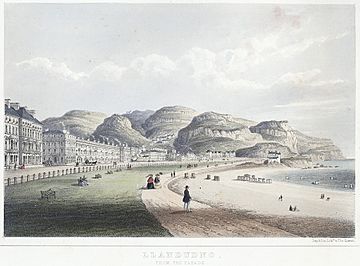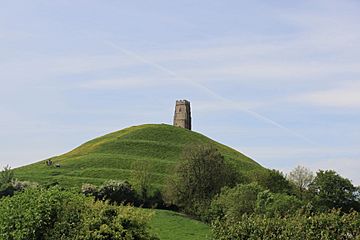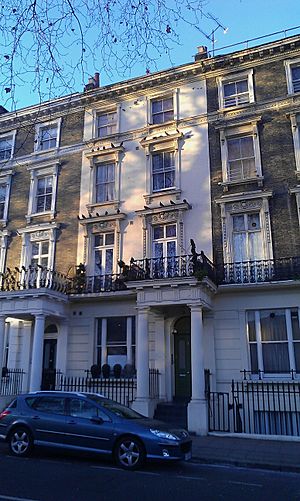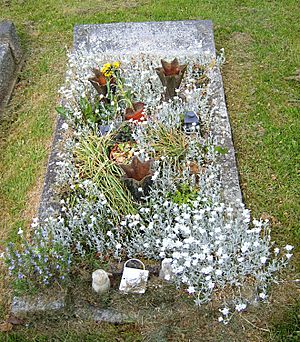Dion Fortune facts for kids
Quick facts for kids
Dion Fortune
|
|
|---|---|
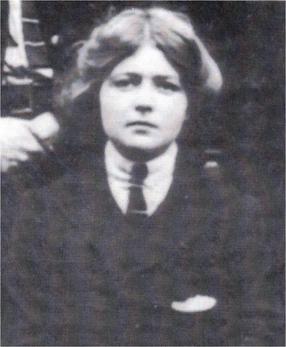
Fortune as a teenager; the image dates from approximately 1905
|
|
| Born |
Violet Mary Firth
6 December 1890 Llandudno, Caernarfonshire, Wales
|
| Died | 6 January 1946 (aged 55) Middlesex, England
|
| Occupation | Occultist, author |
Dion Fortune, born Violet Mary Firth (1890–1946), was a British writer and spiritual teacher. She helped start a group called the Fraternity of the Inner Light. This group taught ideas that she believed came from special spiritual beings called Ascended Masters. She wrote many articles and books about her spiritual beliefs. She also wrote seven novels, some of which explored spiritual themes.
Fortune grew up in Llandudno, North Wales, in a wealthy English family. Later, she lived in England's West Country and wrote two poetry books. She studied psychology and psychoanalysis at the University of London. She then worked as a counselor. During the First World War, she joined the Women's Land Army. She also started a company selling soy milk products.
She became interested in spiritual ideas through the Theosophical Society. She then joined other spiritual groups. Fortune believed she was contacted by Ascended Masters, including "the Master Jesus". She used trance mediumship to share their messages. In 1922, she and Charles Loveday claimed they received a text called The Cosmic Doctrine from these Masters.
She became president of a Christian group within the Theosophical Society. But she felt the society did not focus enough on Christianity. So, she left and formed the Community of the Inner Light. This group later became the Fraternity of the Inner Light. With Loveday, she set up centers in Glastonbury and London. They published a magazine and gave public talks. During the Second World War, she led meditations to protect Britain. She died from leukemia shortly after the war.
Fortune is seen as an important spiritual leader and ceremonial magician of the early 1900s. The Fraternity she founded continued after her death. Her novels influenced later spiritual and modern Pagan groups like Wicca.
Contents
- Early Life and Studies (1890–1913)
- Psychology and Spiritual Interests (1913–1922)
- Glastonbury and The Cosmic Doctrine (1922–1926)
- The Inner Light Community (1927–1930)
- Changes and New Works (1930–1938)
- Later Life and World War II (1939–1946)
- Her Novels
- Beliefs and Teachings
- Personality and Life
- See also
Early Life and Studies (1890–1913)
Violet Mary Firth was born on December 6, 1890, in Llandudno, North Wales. Her family was wealthy and had made money in the steel industry. Her grandfather, John Firth, created a family motto: "Deo, non Fortuna," meaning "God, not Luck." She later used this motto for her spiritual name, Dion Fortune.
Her father, Arthur, ran a law firm before opening a health center in Limpley Stoke, England. Her mother, Sarah Jane Smith, was interested in Christian Science. Not much is known about Fortune's early life in Wales. She later said that from age four, she had visions of Atlantis. She believed these were memories from a past life.
By 1904, Fortune was living in Somerset, England. That year, she published a book of poetry called Violets. Her family likely published it. In 1906, her second poetry book, More Violets, came out.
After her grandfather died, her family moved to London. From 1911 to 1912, Fortune studied at Studley Agricultural College. This college was for horticulture and aimed to help girls with emotional issues. She was good with poultry and worked there for a few months in 1913. She later claimed that the college warden, Lillias Hamilton, mentally harmed her. This led to a mental breakdown, and she left the college.
Psychology and Spiritual Interests (1913–1922)
To recover, Fortune began studying psychotherapy. She first looked into the ideas of Sigmund Freud and Alfred Adler. Later, she focused on Carl Jung. She studied psychology at the University of London. Then, she worked at a psychology clinic in London. She gave lectures that were published in 1922 as The Machinery of the Mind.
While working, she became more interested in spiritual ideas. She attended talks by the Theosophical Society and read their books. As her interest in spiritualism grew, she became less satisfied with psychotherapy.
During the First World War, Fortune joined the Women's Land Army. She worked on a farm and later at a food production base. There, she experimented with making soy milk. She then started the Garden City Pure Food Company to sell her products. She also published a book about soy beans.
While working at the base, she had a spiritual experience. She became more deeply involved in Theosophy. She became focused on the idea of 'Ascended Masters' or 'Secret Chiefs'. She claimed to have seen two of these beings: the Master Jesus and the Master Rakoczi.
Her first spiritual teacher was Theodore Moriarty, an Irish occultist. She met him while working in psychotherapy. She believed he could help a patient who claimed to be troubled by strange physical events. Moriarty performed an exorcism. He said the young man was being affected by the spirit of a dead soldier. Fortune became a follower in Moriarty's group. She joined his community in Bishop's Stortford. Moriarty often spoke about the lost city of Atlantis, a topic Fortune also explored. Fortune later wrote about Moriarty as the character Dr. Taverner in her short stories.
In 1919, Fortune joined the Alpha et Omega, a spiritual group that came from the Hermetic Order of the Golden Dawn. Her main teacher there was Maiya Curtis-Webb, a family friend. Fortune was not very impressed with the ceremonial magic of the Golden Dawn. However, it taught her about the Hermetic Qabalah, which greatly influenced her spiritual views. She also adopted her family's motto, "Deo, non Fortuna," as her own magical motto.
In 1921, Fortune and Curtis-Webb experimented with trance mediumship. Fortune then did a trance mediumship session in Glastonbury with her mother and Frederick Bligh Bond. She claimed to contact spirit-beings called "the Watchers of Avalon." They told her that Glastonbury was once an ancient druidic college. Bond asked Fortune to write an article, "Psychology and Occultism," which was published in 1922.
Glastonbury and The Cosmic Doctrine (1922–1926)
In September 1922, Fortune returned to Glastonbury to visit her friend Charles Loveday. They performed trance mediumship and claimed to connect with Ascended Masters. Fortune later said these Masters included Socrates, Thomas Erskine, and a young officer named David Carstairs. Fortune and Loveday called their method "inspirational mediumship." They believed the Masters communicated through the medium's subconscious mind.
Between 1923 and 1925, Fortune and Loveday claimed to receive a text called The Cosmic Doctrine from the Masters. This text discussed seven planes of the universe. Its ideas were similar to Moriarty's writings and Theosophy. Fortune later published an edited version of The Cosmic Doctrine in 1949.
When Moriarty died in 1923, Fortune tried to become the new leader of his followers. Some accepted her, but many followed Gwen Stafford-Allen instead. Meanwhile, Fortune's parents moved to Letchworth, and Fortune continued her trance mediumship there.
On August 20, 1924, Fortune, Loveday, and others officially formed a spiritual group. Fortune became its "Adeptus." Loveday used money he inherited to help the group. That year, they bought a house in Bayswater, London, to use as a temple and headquarters. They rented out some rooms to help pay for it. The group grew quickly, gaining many new members each year. In 1924, they also bought an old orchard in Glastonbury. They built a hut and chalets there.
Fortune's activities worried Moina Mathers, the leader of Alpha et Omega. Mathers expelled Fortune from her group. Fortune later claimed Mathers then attacked her psychically.
The Inner Light Community (1927–1930)
Fortune and Loveday joined the Christian Mystic Lodge of the Theosophical Society. Fortune soon became its president. Under her leadership, the group grew. She emphasized the importance of 'the Master Jesus' in her writings. She criticized another Theosophical group for not focusing on Jesus.
In October, Fortune resigned from the Theosophical Society. Her Christian Mystic Lodge left the Society and renamed itself the Community of the Inner Light. This Community included a group called the Guild of the Master Jesus. They held regular church services at their London base until 1939. This group later became the Church of the Graal.
When Jiddu Krishnamurti left Theosophy, Fortune supported the 'Back to Blavatsky' group. She criticized Charles Webster Leadbeater, accusing him of black magic. She also worked with B. P. Wadia and his United Lodge of Theosophists. She claimed to contact Himalayan Masters through them. However, she found these Masters "alien and unsympathetic" and "hostile to my race." She left the group, feeling it promoted Indian beliefs too much in Britain. She later claimed Wadia began to attack her psychically.
In April 1927, Fortune married Tom Penry Evans, a Welsh doctor. Their marriage was happy at first. Evans joined Fortune in her spiritual work. Fortune claimed to channel messages from a "Master of Medicine." These messages, received from 1927, focused on alternative medicine. They were later collected as The Principles of Esoteric Medicine.
In 1927, Fortune published her first spiritual novel, The Demon Lover. The next year, she published The Problem of Purity under her birth name, Violet Firth. In 1928, she published The Esoteric Orders and their Work, a book about her beliefs. She followed it with The Training and Work of an Initiate in 1930. Also in 1930, she published Psychic Self-Defense. This book was very popular and included many stories from her own life.
Fortune's group focused on public outreach to gain members. They held regular lectures at their London headquarters. At their Glastonbury property, called the Chalice Orchard, they had a guest house and social center. In 1927, they started a magazine called The Inner Light. It quickly sold out and gained many readers outside Britain. The group had a three-level system for members to progress through. Most members were women. In 1928, they formally established the Fraternity of the Inner Light.
Changes and New Works (1930–1938)
In 1930, Fortune decided to focus less on public work and more on personal spiritual growth. In 1931, she stepped down as leader of the Fraternity, and Loveday took her place. During the 1930s, Fortune focused more on rituals than mediumship. Other Fraternity members continued to use mediumship to channel messages.
Fortune wanted to build a permanent spiritual center at the Chalice Orchard. Despite the Great Depression, she raised enough money. The group saw more people attending lectures and subscribing to their courses. However, their Sunday services were not very popular. Christine Campbell Thomson, Fortune's literary agent, joined the Fraternity.
By 1933, Fortune's marriage faced difficulties. There were rumors about Evans having other relationships. Fortune told friends she married him for spiritual reasons, not love. Evans eventually asked for a divorce. Fortune was upset but did not fight it. Fortune moved to The Belfry, a converted chapel. There, she created new rituals, like the Rite of Isis and the Rite of Pan. During this time, her work became more focused on ancient, nature-based religions.
Fortune published many articles in Inner Light magazine. Some were collected into books. In 1930, Mystical Meditations upon the Collects emphasized her Christian beliefs. In 1931, Spiritualism in the Light of Occult Science showed her concerns about Spiritualism. She believed spirits of the dead should not be contacted without good reason. In 1934, she collected articles about Glastonbury into Avalon of the Heart. Other articles became Practical Occultism in Daily Life, for general readers.
Fortune also wrote many articles about the Hermetic Qabalah for Inner Light. These were published as The Mystical Qabalah. This book is seen as a very important work in her spiritual career. It discussed the Golden Dawn's system of the Qabalic Tree of Life. It was also based on her own experiences. She believed she visited the different Sephiroth of the Qabalic tree during meditation.
In 1935, she published her second spiritual novel, The Winged Bull. In 1936, her third, The Goat-Foot God, came out. In 1938, she wrote The Sea Priestess, which the Fraternity published themselves. Her last novel, Moon Magic, was unfinished when World War II began. A student later completed it, claiming to channel Blavatsky's spirit, and it was published after Fortune's death.
Fortune corresponded with other important spiritualists. She praised Israel Regardie's book The Tree of Life. However, Regardie later said she misrepresented his work. Fortune also corresponded with Olga Fröbe-Kapteyn, a Dutch spiritualist. She renewed her interest in Jungian psychology and was influenced by Friedrich Nietzsche's The Birth of Tragedy.
Later Life and World War II (1939–1946)
The start of the Second World War in September 1939 stopped many of the Fraternity's activities. From 1939 to 1942, Fortune organized Sunday meditations for peace. In 1940, she imagined angelic forces protecting Britain. She believed this visualization helped make it real. She urged Fraternity members to repeat a mantra during bombings. She hoped to call on "Invisible Helpers" to aid people.
The Fraternity's London headquarters were damaged during the Blitz. But repairs were made, and they moved back in a week. In August 1940, they stopped publishing Inner Light due to paper shortages.
After the United States joined the war in 1941, Fortune planned for the post-war period. She believed it would be the start of the Age of Aquarius. In 1942, the Guild's Sunday services restarted. In 1943, Fortune announced a new study course for members. She also considered bringing together all of Europe's spiritualists. She wrote articles that were more positive about spiritualist mediums. She met with Charles Richard Cammell, editor of Light magazine, who then wrote a positive article about her.
By 1942, Fortune corresponded with the famous occultist Aleister Crowley. She praised him as "a genuine adept." She later visited him, and they got along well.
In 1940, Fortune began another trance mediumship project with her Alpha et Omega mentor, Curtis-Webb. They hoped to contact the Masters who had helped the Golden Dawn. They believed they channeled messages from "the Shemesh of the Aquarian Age." These messages, received from 1941 to 1942, became "the Arthurian Formula." They formed the basis of the Fraternity's later work. These channeled messages presented the Arthurian myths as ancient memories from Atlantis. They claimed these memories came to Britain after Atlantis was destroyed.
In late 1945, Fortune became ill. She died from leukaemia in January 1946, at age 55. Her body was buried in Glastonbury. Loveday, who died shortly after, was buried near her. She left most of her money to her Society. Some members worried the organization was becoming too focused on her. So, after her death, they did not encourage interest in her life story. Members claim her successor destroyed most of her diaries and photos. However, some of her books were published after her death, including The Cosmic Doctrine (1949) and Moon Magic (1956).
Her Novels
Fortune wrote seven novels. Four were spiritual and fantasy themed: The Demon Lover, The Winged Bull, The Goat-Foot God, and The Sea Priestess. These are compared to works by writers like H. Rider Haggard. The other three were romantic thrillers published under the name "V. M. Steele": The Scarred Wrists, Hunters of Humans, and Beloved of Ishmael. Writing thrillers was one of the few things Fortune did that was not directly linked to her spiritual work. She did not publicize these books. An eighth novel, Moon Magic, was finished by a student and published after her death.
Fortune saw her spiritual novels as important for her Fraternity's work. She believed they could introduce readers to spiritual ideas by speaking to their subconscious minds. She thought they were a way to share her teachings with more people. Each novel was linked to one of the Sephirah on the Qabalic Tree of Life. For example, The Winged Bull was linked to Tiphareth, and The Sea Priestess to Yesod.
Fortune's first novel, The Demon Lover, is about Veronica Mainwaring. She is a young woman who becomes secretary to a magician, Justin Lucas. He tries to use her spiritual powers for his own goals. She falls in love with him but escapes through her devotion to Christianity. Her next book, The Winged Bull, focuses on Ursula Brangwyn. She was hurt by a bad spiritual group but meets and marries Ted Murchison. The characters in The Winged Bull are based on real people in Fortune's life.
The Goat-Foot God is about a wealthy widower, Hugh Patson. He teams up with a bookseller to find the ancient Greek god Pan. They succeed with the help of an artist, Mona Wilton. The Sea Priestess is about Wilfred Maxwell, who learns to connect with the Moon. He meets Le Fay Morgan, a spiritual expert. They form a close, but not romantic, relationship. They also create a temple to sea gods.
Fortune's novels often follow a similar pattern. A strong female character, a priestess, meets a man and helps him. In her later novels, these pairs rebuild or revive a ritual space. They perform spiritual rituals to balance cosmic forces.
One unique part of Fortune's fiction is the recurring story of spiritual romance from the priestess's point of view. Her female characters offered a model for female readers in their own spiritual practices. There were two types of priestesses in her novels: the "Earth Mother" and the "Moon Mistress." The "Earth Mother" characters got their power from masculine and feminine energies. They needed a male priest to help them reach their full potential. The "Moon Mistress" was a celibate figure. She focused her creative energy on training priestesses and dealing with spiritual matters.
Beliefs and Teachings
Religion and Race
Fortune called her beliefs part of "the Western Mystery Tradition." She followed a form of esoteric Christianity. She is described as a "Christian Qabalist" and a "devout mystical Christian," though her views were unusual. She believed that "Christ Jesus, the Great Initiator of the West," was central to Western spiritual schools. She saw "the Master Jesus" as her personal spiritual guide. She thought the teachings from the Hermetic Order of the Golden Dawn helped recover "sacred mysteries" that mainstream Christianity had overlooked. She did not belong to any official Christian churches and often criticized mainstream clergy. She also rejected some traditional Christian ideas about Heaven and Hell.
There is no proof that Fortune considered herself "Pagan." However, by the late 1930s, she became more interested in ancient Egyptian religion. At first, she saw it as a step towards Christianity. But her attitude changed, and she became more open to pre-Christian religions. This was likely influenced by her husband and other writers. In her novel The Winged Bull, she said pre-Christian gods were as valid as the Christian God. She also began to criticize Christianity, saying it had been changed and distorted. In The Goat-Foot God, Fortune fully embraced the idea of a modern Paganism. She called it "Vitamin P" and said it was needed to heal the modern world. Around this time, she promoted the idea that "All the gods are one god, and all the goddesses are one goddess." However, during the Second World War, her writings became more Christian again.
Fortune believed there was a common link between Western spiritual groups and Asian religious traditions. But she also thought that specific spiritual traditions belonged to certain racial groups. She stated that "the Great White Lodge gives to each race the religion suited to its needs." She believed that mixing spiritual techniques between different cultures could cause harm. For example, she warned against Western spiritual teachings being practiced in India. She also strongly opposed Westerners adopting Asian religious techniques. She recommended "the traditional Western system" for white races. She did see value in Westerners studying Asian practices like Yoga in theory, but not in practice. In the 21st century, some of her ideas about race might be seen as prejudiced. However, during her time, ideas about the link between "culture, race, and religion" were common.
Magic
Fortune was a ceremonial magician. Her Fraternity's magical principles came from the Hermetic Order of the Golden Dawn. They also drew from Theosophy and Christian Science. The magical ceremonies performed by Fortune's Fraternity had two types. Initiations introduced a person to magical forces. Evocations manipulated these forces for a specific purpose.
The Fraternity's rituals in their London temple were done in dim light. Fortune believed bright light scattered spiritual forces. An altar was in the center of the room. Its cloth and symbols changed based on the ceremony. A light was on the altar, and frankincense was usually burned. Senior officers sat at one end of the room. Other officers, believed to be channels for cosmic forces, stood in different places. The group began by walking in a circle and chanting. This was meant to build a psychic wall. Then, cosmic beings would be called upon. Members believed these beings would appear in spiritual form and interact with the chosen officers.
Fortune helped popularize the idea of a division between the left-hand path and right-hand path. This idea came from Theosophist Helena Blavatsky. Fortune linked her negative views of the left-hand path to concerns about homosexuality in British society. Her writings condemned "homosexual techniques" of harmful male magicians. She claimed that accepting homosexuality caused the downfall of ancient Greek and Roman civilizations.
Personality and Life
Historian Claire Fanger noted that Fortune had a "dynamic personality and confident leadership." Janine Chapman, a spiritual researcher, described Fortune as "a strong, magnetic personality" with "an active, intellectually curious mind." She also said Fortune was "physically imposing." Chapman noted that Fortune had a "keen sense of humor" and enjoyed practical jokes while at college. Alan Richardson described Fortune as "honest, and often ruthless with her honesty." He added that she was "an essentially good woman who had strands of darkness within." In her later years, her friends in the Fraternity called her "The Fluff."
Chapman said Fortune's marriage was "rocky." Fortune did not have any children.
Fortune and her group did not get involved in politics. Historian Ronald Hutton suggested Fortune's political views were likely similar to a High Tory. Richardson noted she was "somewhat aligned" with the ideas of Winston Churchill. Susan Johnson Graf noted that Fortune was not part of the feminist movement. However, she "thought herself every bit as powerful, capable, independent, and discerning as any man." She worked to spiritually empower women. When staying in Queensborough, Fortune followed a vegetarian diet.
See also
 In Spanish: Dion Fortune para niños
In Spanish: Dion Fortune para niños
- Margaret Lumley Brown


